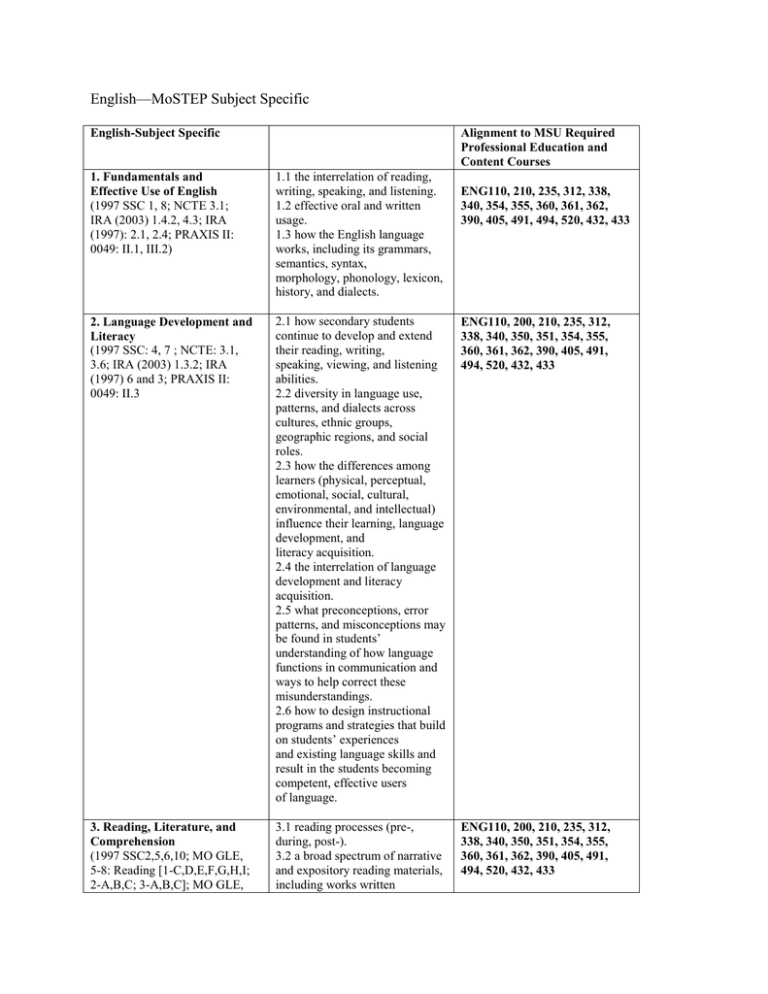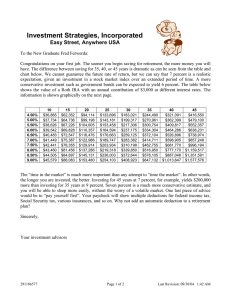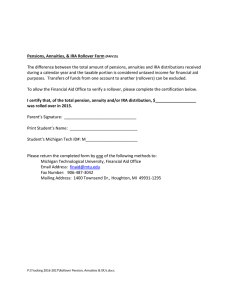English—MoSTEP Subject Specific
advertisement

English—MoSTEP Subject Specific English-Subject Specific Alignment to MSU Required Professional Education and Content Courses 1. Fundamentals and Effective Use of English (1997 SSC 1, 8; NCTE 3.1; IRA (2003) 1.4.2, 4.3; IRA (1997): 2.1, 2.4; PRAXIS II: 0049: II.1, III.2) 1.1 the interrelation of reading, writing, speaking, and listening. 1.2 effective oral and written usage. 1.3 how the English language works, including its grammars, semantics, syntax, morphology, phonology, lexicon, history, and dialects. 2. Language Development and Literacy (1997 SSC: 4, 7 ; NCTE: 3.1, 3.6; IRA (2003) 1.3.2; IRA (1997) 6 and 3; PRAXIS II: 0049: II.3 2.1 how secondary students continue to develop and extend their reading, writing, speaking, viewing, and listening abilities. 2.2 diversity in language use, patterns, and dialects across cultures, ethnic groups, geographic regions, and social roles. 2.3 how the differences among learners (physical, perceptual, emotional, social, cultural, environmental, and intellectual) influence their learning, language development, and literacy acquisition. 2.4 the interrelation of language development and literacy acquisition. 2.5 what preconceptions, error patterns, and misconceptions may be found in students’ understanding of how language functions in communication and ways to help correct these misunderstandings. 2.6 how to design instructional programs and strategies that build on students’ experiences and existing language skills and result in the students becoming competent, effective users of language. ENG110, 200, 210, 235, 312, 338, 340, 350, 351, 354, 355, 360, 361, 362, 390, 405, 491, 494, 520, 432, 433 3. Reading, Literature, and Comprehension (1997 SSC2,5,6,10; MO GLE, 5-8: Reading [1-C,D,E,F,G,H,I; 2-A,B,C; 3-A,B,C]; MO GLE, 3.1 reading processes (pre-, during, post-). 3.2 a broad spectrum of narrative and expository reading materials, including works written ENG110, 200, 210, 235, 312, 338, 340, 350, 351, 354, 355, 360, 361, 362, 390, 405, 491, 494, 520, 432, 433 ENG110, 210, 235, 312, 338, 340, 354, 355, 360, 361, 362, 390, 405, 491, 494, 520, 432, 433 5-8: Information Literacy [1A,B]; NCTE: 3.2, 3.3, 3.5., 3.6; IRA (2003) 1.1.2, 4.1.2, 4.2.2, 4.2.3, 4.3, 4.4.2; IRA (1997) 1.3, 1.4, 1.5 , 2.6, 2.6, 2.12, 2.13, 5.1, 5.2, 5.3, 6.1, 6.2, 6.3, 6.4, 6.5, 6.6, 7.1, 7.2, 7.3, 7.4, 7.5, 8.1; ETS: 0049: I.1-I.7; IV.1) specifically for young adults, encompassing different topics, themes, genres, and nonfiction; as well as a broad historical and contemporary spectrum of United States, British, and world literature, including a range of cultures, male and female authors of various cultures and ethnic origins. 3.3 strategies to monitor and increase reading comprehension. 3.4 techniques and strategies for the ongoing development of independent vocabulary acquisition. 3.5 how to locate and use a variety of print and non-print reference sources. 3.6 the characteristics of literary types and forms. 3.7 how to help students think critically about what they read. 3.8 methods for promoting personalized reactions to reading and the value of sharing those responses. 3.9 a variety of critical approaches to interpreting text 4. Thinking and Communicating Through Writing, Speaking, and Listening (1997 SSC 3, 9; MO GLE, 5-8: Writing [1-A; 2-B,C,D,E,F; 3A,B,C,D,E]; MO GLE, 9-12: Listening & Speaking [1-A,B; 2-A]; MO GLE, 5-8: Information Literacy [2-A]; ACEI 11, 12, 13, 14; NCTE: 2.4, 3.2, 3.4; IRA (2003) 4.3; IRA (1997) 2.6, 2.7, 9.1, 9.2; ETS: 0049: III.1, III.2; IV.2) 4.1 a broad range of pre-, during, and post-writing strategies to generate meaning and to clarify understanding. 4.2 varied methods of argument, types of appeals, and persuasive strategies in writing and speaking. 4.3. use of evidence and documentation. 4.4 composing processes used to prepare information to share orally, visually, and/or in writing. 4.5 different organizational patterns and strategies used for writing and speaking for different audiences and purposes. 4.6 ways of creating instruction, activities, and experiences that develop varied writing, speaking and presentation skills to communicate with different audiences for a variety of purposes. 4.7 how to respond to film, video, ENG110, 200, 210, 235, 312, 338, 340, 350, 351, 354, 355, 360, 361, 362, 405, 520, 432, 433 graphic, photographic, audio, and multimedia texts. 4.8 technology used to enhance learning and reflection on learning. 4.9 how to help students develop the capacity to listen so they comprehend, analyze, consider, respond to, and discuss spoken material, non-fiction, fiction, dramatic works, and poetry.

